Abstract
Thirty strains of human oral anaerobic spirochetes were isolated in three different media: veal heart infusion-ascitic fluid, Spirolate-Brain Heart Infusion-rabbit serum, and supplemented PPLO broth. The morphological and biochemical characteristics of the isolates permitted their differentiation into three distinct species: Treponema denticola, T. macrodentium, and T. oralis (proposed new species). These species could be differentiated as follows. Organisms of the T. denticola type had a “2-4-2” axial fibril relationship as determined by electron microscopy, required serum for growth, did not utilize glucose or lactate, and produced indole, ammonia, acetate, and lactate as end products. T. macrodentium had a “1-2-1” axial fibril relationship, did not require serum, utilized glucose but not lactate, did not produce indole or ammonia, and produced formate, acetate, lactate, and succinate as acid end products. T. oralis had a “1-2-1” axial fibril relationship, required serum for growth, utilized lactate but not glucose, produced indole but not ammonia, and produced propionate and acetate as acid end products.
Full text
PDF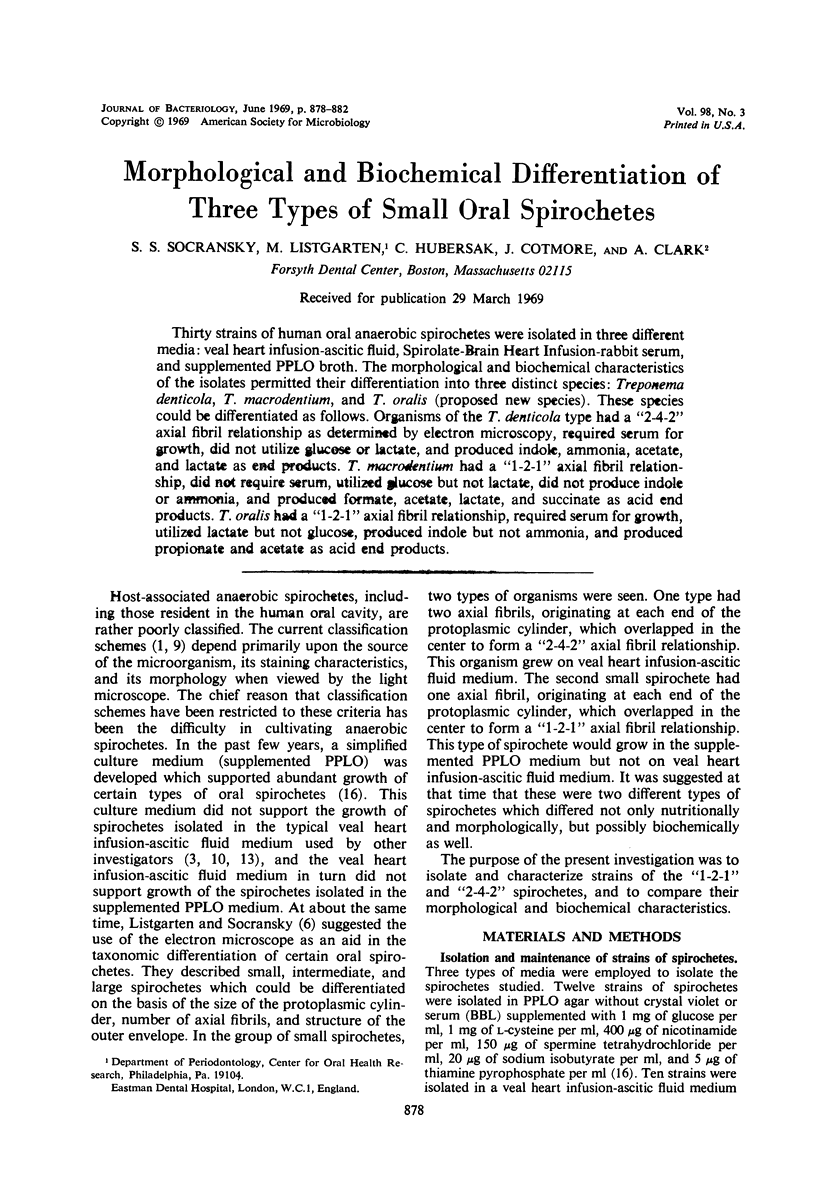
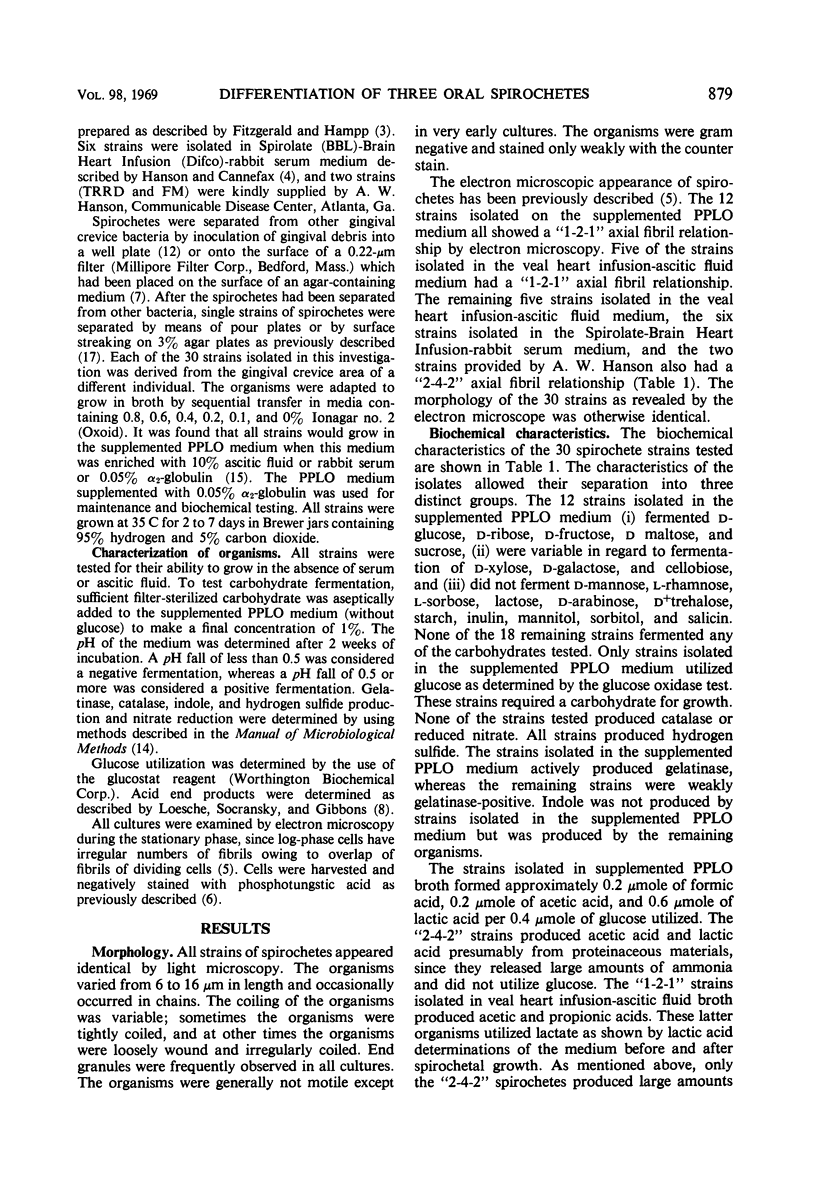
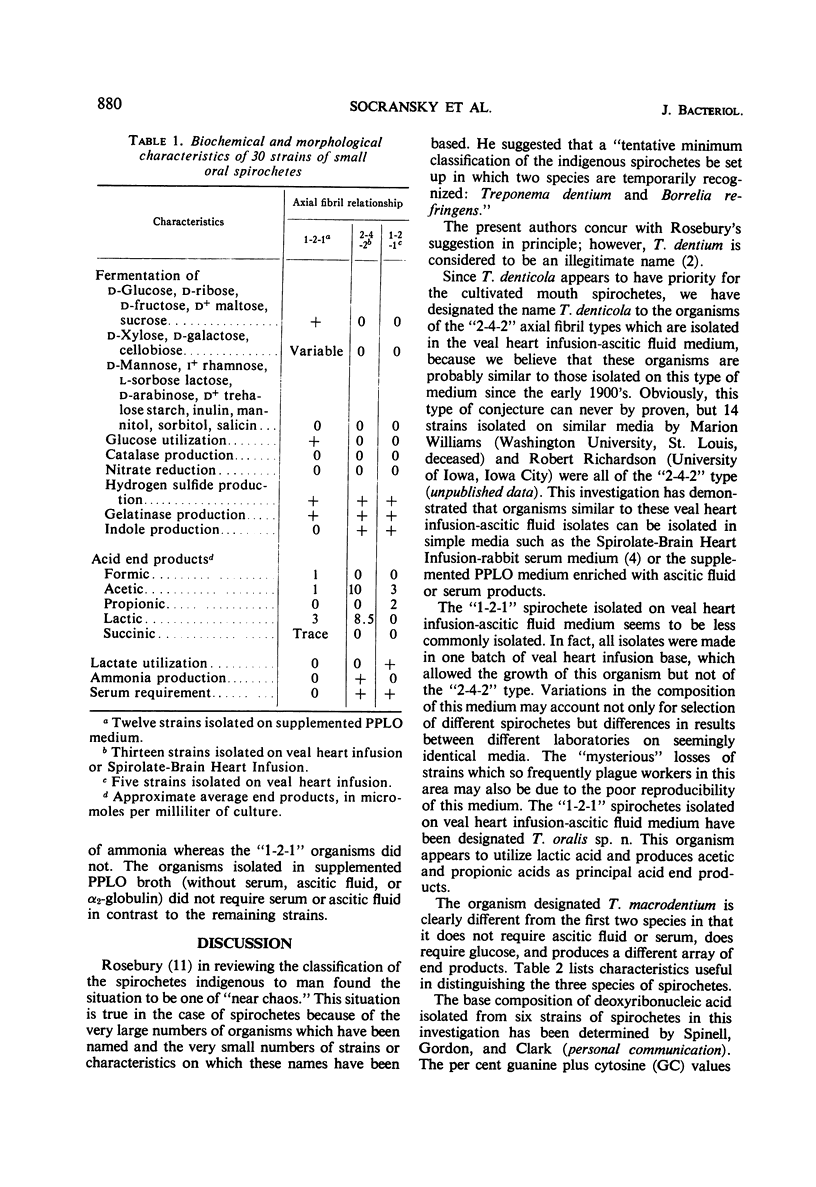
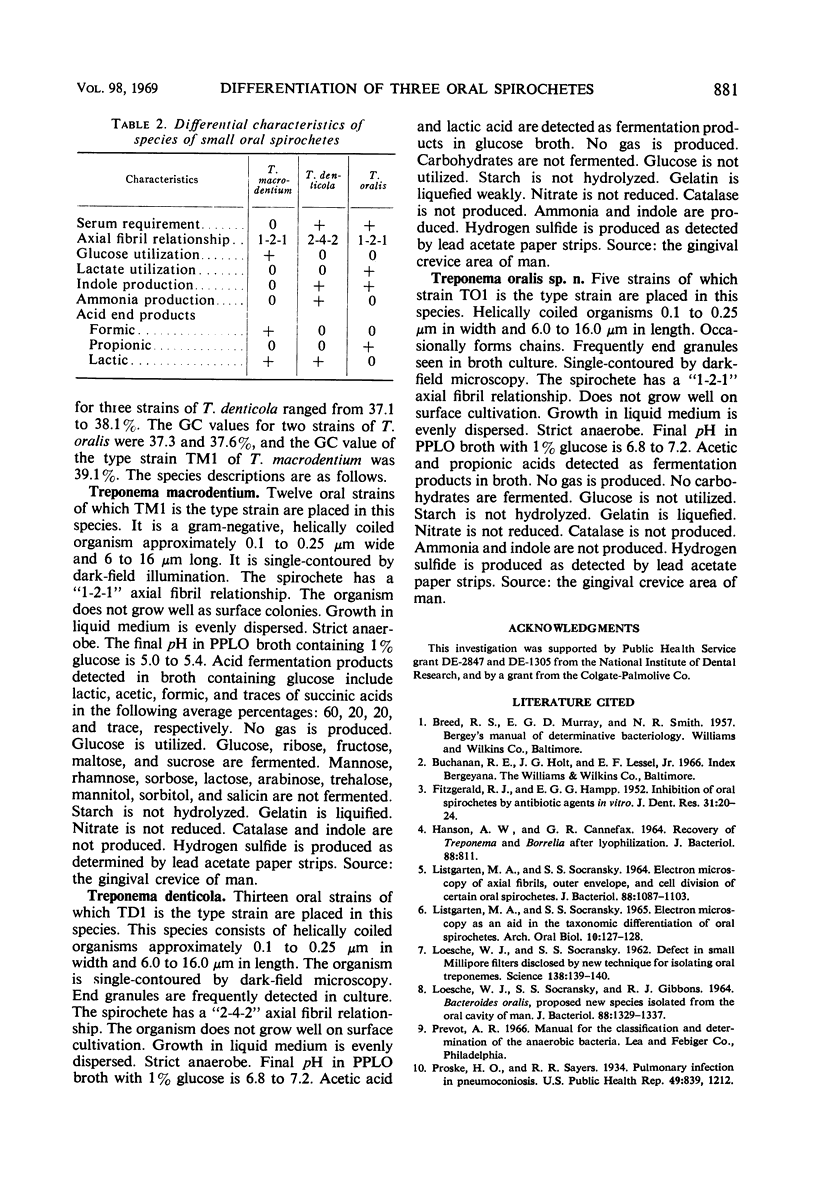
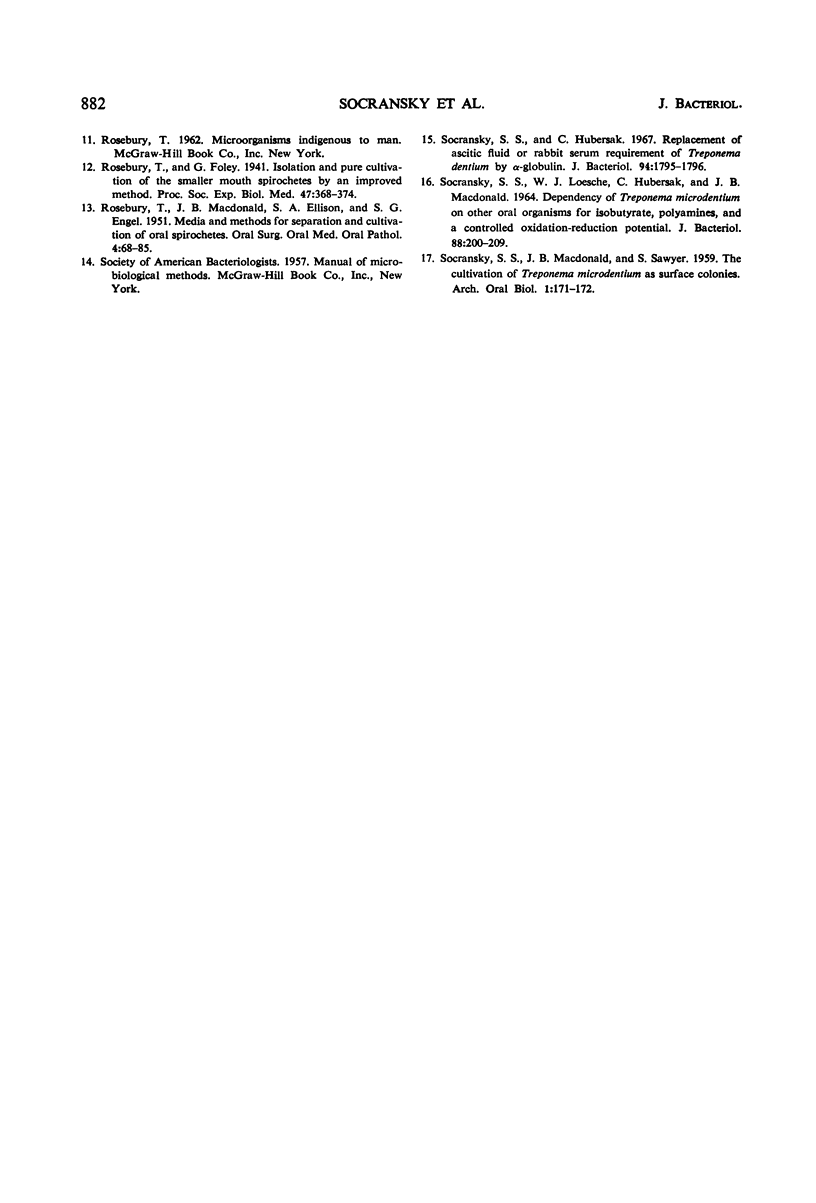
Selected References
These references are in PubMed. This may not be the complete list of references from this article.
- FITZGERALD R. J., HAMPP E. G. Inhibition of oral spirochetes by antibiotic agents in vitro. J Dent Res. 1952 Feb;31(1):20–24. doi: 10.1177/00220345520310011501. [DOI] [PubMed] [Google Scholar]
- HANSON A. W., CANNEFAX G. R. RECOVERY OF TREPONEMA AND BORRELIA AFTER LYOPHILIZATION. J Bacteriol. 1964 Sep;88:811–811. doi: 10.1128/jb.88.3.811-811.1964. [DOI] [PMC free article] [PubMed] [Google Scholar]
- LISTGARTEN M. A., SOCRANSKY S. S. ELECTRON MICROSCOPY AS AN AID IN THE TAXONOMIC DIFFERENTIATION OF ORAL SPIROCHETES. Arch Oral Biol. 1965 Jan-Feb;10:127–138. doi: 10.1016/0003-9969(65)90064-6. [DOI] [PubMed] [Google Scholar]
- LISTGARTEN M. A., SOCRANSKY S. S. ELECTRON MICROSCOPY OF AXIAL FIBRILS, OUTER ENVELOPE, AND CELL DIVISION OF CERTAIN ORAL SPIROCHETES. J Bacteriol. 1964 Oct;88:1087–1103. doi: 10.1128/jb.88.4.1087-1103.1964. [DOI] [PMC free article] [PubMed] [Google Scholar]
- LOESCHE W. J., SOCRANSKY S. S. Defect in small millipore filters disclosed by new technique for isolating oral treponemes. Science. 1962 Oct 12;138(3537):139–140. doi: 10.1126/science.138.3537.139. [DOI] [PubMed] [Google Scholar]
- LOESCHE W. J., SOCRANSKY S. S., GIBBONS R. J. BACTEROIDES ORALIS, PROPOSED NEW SPECIES ISOLATED FROM THE ORAL CAVITY OF MAN. J Bacteriol. 1964 Nov;88:1329–1337. doi: 10.1128/jb.88.5.1329-1337.1964. [DOI] [PMC free article] [PubMed] [Google Scholar]
- ROSEBURY T., MACDONALD J. B., ELLISON S. A., ENGEL S. G. Media and methods for separation and cultivation of oral spirochetes. Oral Surg Oral Med Oral Pathol. 1951 Jan;4(1):68–85. doi: 10.1016/0030-4220(51)90525-7. [DOI] [PubMed] [Google Scholar]
- SOCRANSKY S. S., LOESCHE W. J., HUBERSAK C., MACDONALD J. B. DEPENDENCY OF TREPONEMA MICRODENTIUM ON OTHER ORAL ORGANISMS FOR ISOBUTYRATE, POLYAMINES, AND A CONTROLLED OXIDATION-REDUCTION POTENTIAL. J Bacteriol. 1964 Jul;88:200–209. doi: 10.1128/jb.88.1.200-209.1964. [DOI] [PMC free article] [PubMed] [Google Scholar]
- SOCRANSKY S., MACDONALD J. B., SAWYER S. The cultivation of Treponema microdentium as surface colonies. Arch Oral Biol. 1959 Oct;1:171–172. doi: 10.1016/0003-9969(59)90009-3. [DOI] [PubMed] [Google Scholar]
- Socransky S. S., Hubersak C. Replacement of ascitic fluid or rabbit serum requirement of Treponema dentium by alpha-globulin. J Bacteriol. 1967 Nov;94(5):1795–1796. doi: 10.1128/jb.94.5.1795-1796.1967. [DOI] [PMC free article] [PubMed] [Google Scholar]


